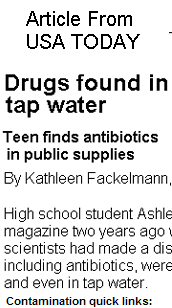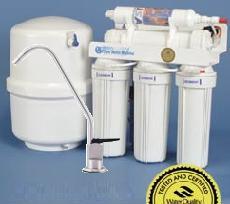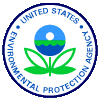 |
|
Drugged Drinking Water
Carol Potera / Environmental Health Perspectives v.108, n.10, Oct00
Drugs and personal care products that are excreted from or washed off the body naturally end up in the sewage that flows into sewer systems and septic tanks, but where do they go from there? Scientists are beginning to monitor the extent of pharmaceutical and personal care products (PPCPs) in the aquatic environment and their consequences. What they're finding is that, through leaching from septic tanks and escaping intact through sewage treatment processes, some of these substances are ending up back in the drinking water.
Germany has been at the forefront of PPCP monitoring. Studies conducted there during the past 10 years confirmed the presence of PPCPs in treated and untreated sewage effluent, surface water, groundwater, and drinking water. Most commonly found were anti-inflammatory and pain-killing drugs, cholesterol-lowering drugs, anticonvulsants, and sex hormones from oral contraceptives. Samples from 40 German rivers and streams turned up residues of 31 different PPCPs, according to a report presented at the March 2000 American Chemical Society meeting in San Francisco, California, by Thomas Ternes, a chemist at the Institute for Water Research and Water Technology in Wiesbaden.
Researchers worldwide have discovered more than 60 different PPCPs in water sources, according to Christian Daughton, chief of the Environmental Chemistry Branch of the U.S. Environmental Protection Agency (EPA) Environmental Sciences Division in Las Vegas, Nevada. In addition to the drugs noted above, the list includes antineoplastics, beta-blockers, bronchodilators, lipid regulators, hypnotics, antibiotics, antiseptics, X-ray contrast agents, sunscreen agents, caffeine, and fragrances such as synthetic musks. Most PPCPs are detected at concentrations ranging from parts per trillion to parts per billion, and originate in treated and untreated sewage, says Daughton, who coauthored an article on PPCPs in the December 1999 issue of EHP Supplements.
North American researchers are just beginning to look at the issue of PPCPs. Studies presented at the June 2000 Emerging Issues Conference sponsored by the National Ground Water Association, held in Minneapolis, Minnesota, indicate that the problem exists here, too. For example, environmental scientist Chris Metcalfe of Trent University in Peterborough, Ontario, detected the drugs aspirin, ibuprofen, indomethacin, bezafibrate (a cholesterol regulator), and carbamazepine (an anticonvulsant) in 10 pre- and post-treatment samples from sewage treatment plants in eastern Canada. The sewage treatment process in place removed some drugs that were easily biodegradable or more amenable to removal by activated charcoal, degradative microbes, or sand filtration, but others were resistant to degradation.
 |
Metcalfe is just beginning to
analyze the effects of cholesterol-lowering drugs, estrogens,
and anticonvulsants on fish in the Great Lakes. All three drug
types can potentially interfere with normal reproduction and
development in fish living downstream from sewage treatment
plants. His laboratory studies show that estrogen compounds at
parts-per-trillion exposures feminize male fish and disrupt the
development of the circulatory system, eyes, and bladder. He
says it's too soon to know whether PPCPs adversely affect wild
fish populations.
In one of the first studies in the United States to report the occurrence of drugs in drinking water, environmental engineer Glen Boyd had his students at Tulane University in New Orleans, Louisiana, sample water from the Mississippi River, a local lake, and city tap water. Their preliminary experiment targeted the pain reliever naproxen, the sex hormone estrone, and clofibric acid, a major bioactive metabolite from certain anticholesterol drugs. All three were detected at varying concentrations in most of the samples. "The big unknown," says Boyd, "[is whether PPCPs] present a health concern now or in the future." He notes that, although the number of peer-reviewed papers on the topic is limited, government agencies concerned with water quality in the United States and professional organizations serving the water and wastewater communities are beginning to acknowledge PPCPs as an emerging environmental issue. |
The long-term outcome of humans ingesting subtherapeutic doses of numerous drugs as well as any dose at all of substances not meant to be ingested remains a major unaddressed issue. "In areas of water scarcity, we'll see more and more reuse of treated sewage to meet drinking water needs," predicts Daughton, thereby increasing the likelihood that PPCPs will end up in drinking water. Extensive monitoring of the occurrence of PPCPs and their concentration trends over time is required to ensure safe water supplies in the future. Then toxicologists need to determine if the kinds and amounts of PPCPs that occur affect people and other living creatures. This subject will require collaboration between the Food and Drug Administration and the EPA, says Daughton, since the former usually does not address environmental concerns and the latter generally does not deal with drug issues.
Report
ends here.










